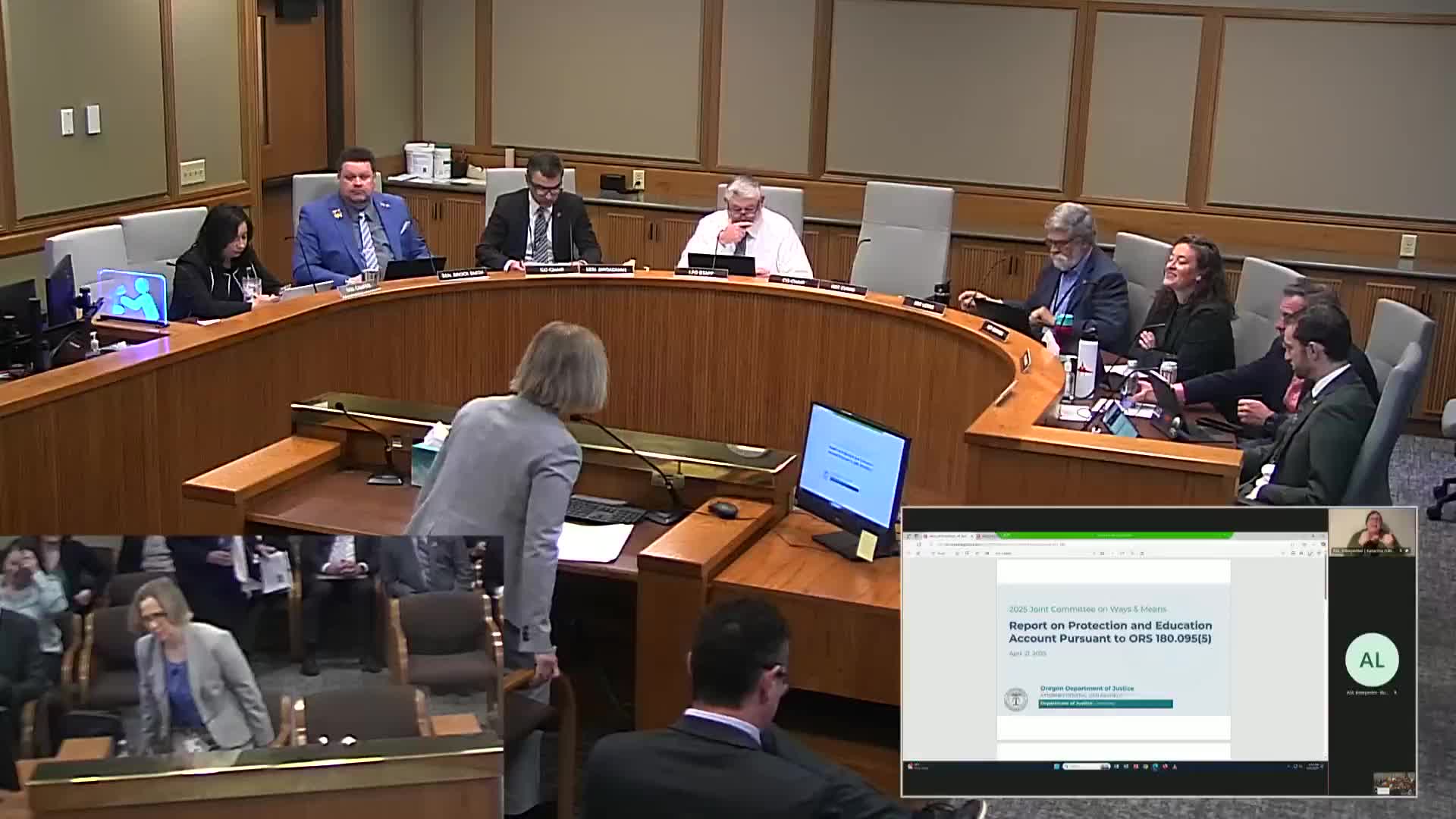DOJ: Protection and Education account projects $47.3M balance; subcommittee acknowledges biennial report
April 21, 2025 | Public Safety, Ways and Means, Joint, Committees, Legislative, Oregon
This article was created by AI summarizing key points discussed. AI makes mistakes, so for full details and context, please refer to the video of the full meeting. Please report any errors so we can fix them. Report an error »

The Public Safety Subcommittee acknowledged receipt of the Department of Justice’s biennial report on the Protection and Education account on Monday, April 21, 2025.
The department said the P&E account — created and governed by Oregon Revised Statute (as cited in testimony) — holds revenues from enforcement recoveries and funds DOJ’s consumer protection, antitrust and false‑claims work. Claudia Groberg, chief counsel of the Civil Enforcement Division, described the account succinctly: “This is a self funded program.”
Why it matters: The P&E account finances ongoing investigations and litigation the state brings to recover funds and redress consumer and public‑program harms. DOJ testimony outlined projected operating balances and how some settlement proceeds are distributed outside the P&E account to restitution, state agencies, or statutory accounts that fund harm‑specific programs.
Key figures DOJ presented:
• Ending balance projected (as of February 2025) for the 2023–25 biennium: about $47,300,000.
• Projected current‑service expenditures for the 2025–27 biennium: approximately $25,500,000; conservative revenue estimate for 2025–27: $7,000,000, yielding a projected ending balance of about $29,000,000 at the end of 2025–27.
• Longer‑range projection for 2027–29 (noted as speculative): a projected ending balance near $9,000,000, with the department noting high uncertainty that far out.
DOJ described three categories where settlement proceeds do not go into the P&E account in full: false‑claims recoveries for public entities (first repay attorney fees, reimburse agencies, then remaining proceeds to P&E), consumer restitution (distributed to harmed consumers, often via a contractor), and statutory or judicial distributions that fund harm‑specific programs. Examples provided:
• Centene and a pediatric therapeutic‑services settlement tied to Medicaid false‑claims work; portions reimbursed to the Oregon Health Authority (OHA) and Medicaid fraud units before P&E deposits.
• JUUL settlement proceeds are deposited into a statutory account at the Oregon Health Authority to fund youth cessation, prevention and outreach programs.
• Opioid settlements are largely placed in the opioid prevention, treatment and recovery fund or allocated directly to local governments for opioid abatement.
• Johnson & Johnson talc settlement for Oregon: $10,000,000 to P&E over four years, plus direct payments from J&J to Oregon women’s health charities for screening and prevention work; DOJ clarified the charity payments come from J&J, not the Oregon account.
DOJ also described consumer restitution distributions in cases such as Avanti and COVID clinic settlements where portions were returned to consumers and portions used to cover DOJ costs.
Committee action: DAS CFO and LFO each recommended acknowledging receipt of the report. Representative Lewis moved to approve the LFO recommendation; the motion passed and will be carried to the full committee.
The department said the P&E account — created and governed by Oregon Revised Statute (as cited in testimony) — holds revenues from enforcement recoveries and funds DOJ’s consumer protection, antitrust and false‑claims work. Claudia Groberg, chief counsel of the Civil Enforcement Division, described the account succinctly: “This is a self funded program.”
Why it matters: The P&E account finances ongoing investigations and litigation the state brings to recover funds and redress consumer and public‑program harms. DOJ testimony outlined projected operating balances and how some settlement proceeds are distributed outside the P&E account to restitution, state agencies, or statutory accounts that fund harm‑specific programs.
Key figures DOJ presented:
• Ending balance projected (as of February 2025) for the 2023–25 biennium: about $47,300,000.
• Projected current‑service expenditures for the 2025–27 biennium: approximately $25,500,000; conservative revenue estimate for 2025–27: $7,000,000, yielding a projected ending balance of about $29,000,000 at the end of 2025–27.
• Longer‑range projection for 2027–29 (noted as speculative): a projected ending balance near $9,000,000, with the department noting high uncertainty that far out.
DOJ described three categories where settlement proceeds do not go into the P&E account in full: false‑claims recoveries for public entities (first repay attorney fees, reimburse agencies, then remaining proceeds to P&E), consumer restitution (distributed to harmed consumers, often via a contractor), and statutory or judicial distributions that fund harm‑specific programs. Examples provided:
• Centene and a pediatric therapeutic‑services settlement tied to Medicaid false‑claims work; portions reimbursed to the Oregon Health Authority (OHA) and Medicaid fraud units before P&E deposits.
• JUUL settlement proceeds are deposited into a statutory account at the Oregon Health Authority to fund youth cessation, prevention and outreach programs.
• Opioid settlements are largely placed in the opioid prevention, treatment and recovery fund or allocated directly to local governments for opioid abatement.
• Johnson & Johnson talc settlement for Oregon: $10,000,000 to P&E over four years, plus direct payments from J&J to Oregon women’s health charities for screening and prevention work; DOJ clarified the charity payments come from J&J, not the Oregon account.
DOJ also described consumer restitution distributions in cases such as Avanti and COVID clinic settlements where portions were returned to consumers and portions used to cover DOJ costs.
Committee action: DAS CFO and LFO each recommended acknowledging receipt of the report. Representative Lewis moved to approve the LFO recommendation; the motion passed and will be carried to the full committee.
View full meeting
This article is based on a recent meeting—watch the full video and explore the complete transcript for deeper insights into the discussion.
View full meeting
